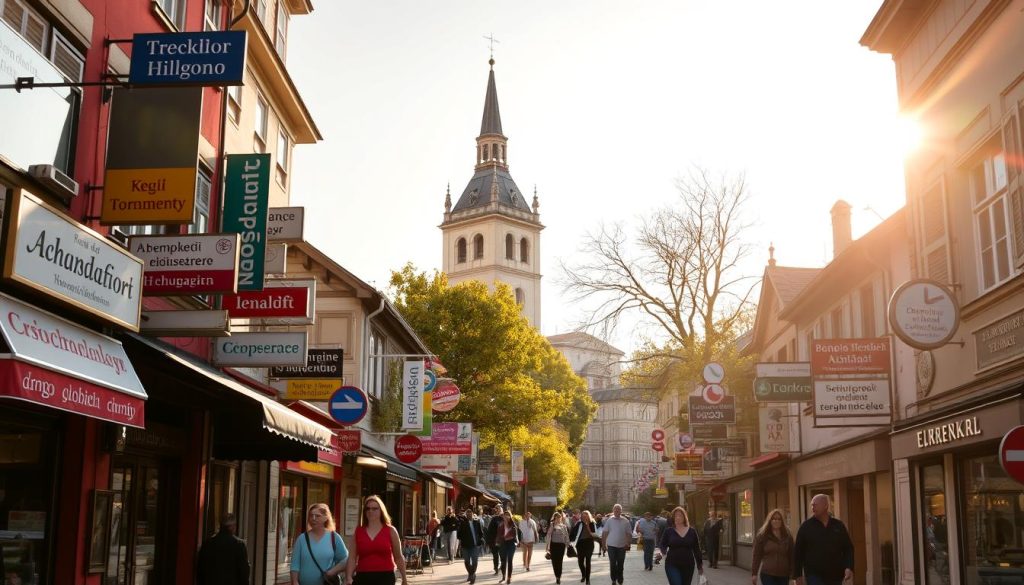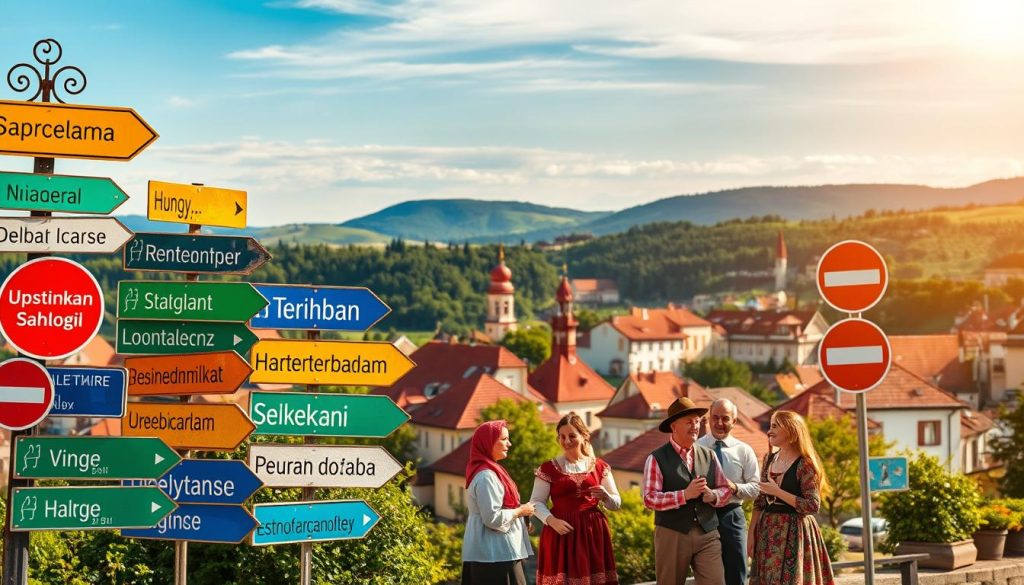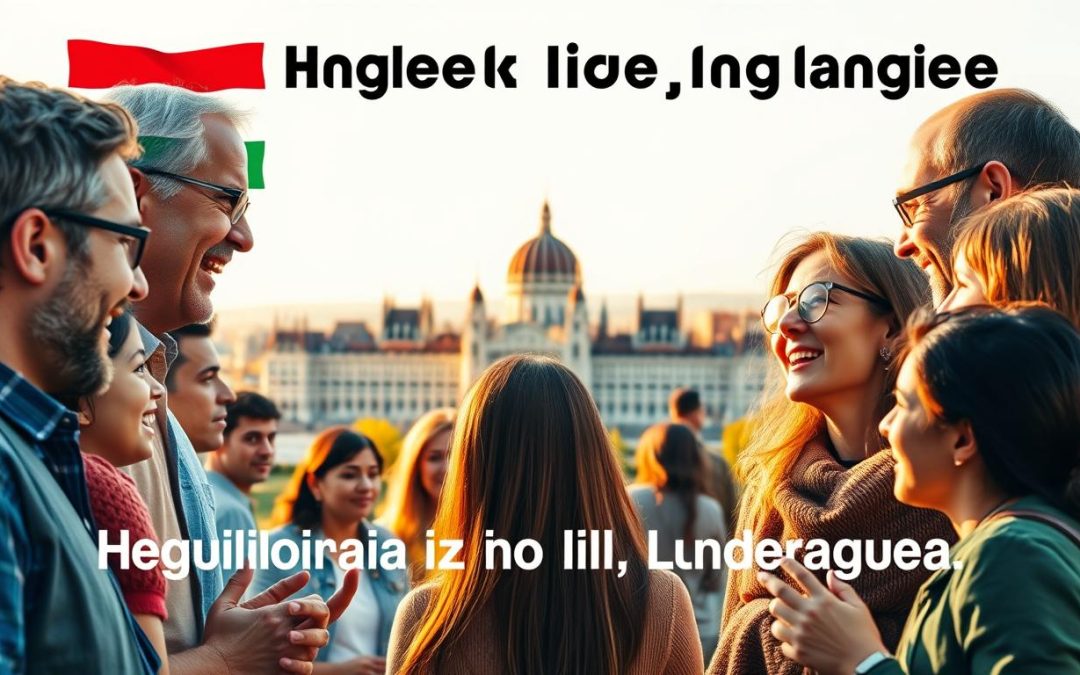Have you ever wondered how a language can shape a country’s identity? In one European nation, nearly 99.6% of the population speaks the same tongue. This linguistic unity is not just a statistic—it’s a cornerstone of cultural pride and heritage.
Hungarian is more than just a means of communication. It’s a symbol of unity and tradition, officially recognized in the European Union. With over 13 million native speakers worldwide, it’s a language that connects people across borders.
This section dives into the pivotal role of Hungarian in daily life and its importance within the nation. You’ll also discover how it bridges generations and unites communities, both at home and abroad.
Key Takeaways
- Hungarian is the primary language, spoken by 99.6% of the population.
- It holds official status in the European Union.
- Nearly all residents speak it as their first language.
- Hungarian is a key part of cultural identity and heritage.
- It connects millions of speakers globally, including diaspora communities.
Hungary: Official and widely spoken languages – An Overview
What makes a language stand out in a region filled with diverse tongues? In this European nation, one language dominates nearly every aspect of life. It’s not just a tool for communication—it’s a cornerstone of identity.

Defining the Linguistic Landscape
Hungarian belongs to the Uralic family, setting it apart from most European languages. Its unique structure and vocabulary make it distinct. This language is deeply rooted in history, reflecting centuries of cultural evolution.
Unlike its neighbors, Hungarian doesn’t share many similarities with Slavic or Germanic tongues. This uniqueness strengthens its role as a unifying force. It’s a symbol of pride for millions of speakers.
Key Statistical Insights
With over 9.9 million native speakers, Hungarian is the primary language in the country. Nearly 99% of the population speaks it as their first tongue. This widespread usage highlights its importance in daily life.
Beyond borders, Hungarian connects communities in neighboring countries. It’s a vital link for diaspora groups, preserving cultural ties. The language continues to thrive, adapting to modern needs while honoring tradition.
The Cultural Impact of the Hungarian Language
How does a language influence the way a community sees itself? For millions of speakers, Hungarian is more than a means of communication—it’s a cornerstone of identity. Its roots stretch back centuries, shaping traditions and uniting people across generations.
Historical Roots and National Identity
Hungarian’s history is deeply tied to the nation’s sense of self. Ancient texts like the Funeral Sermon and Prayer highlight its role in preserving cultural heritage. This spoken language has been a unifying force, even during times of political change.
Its unique structure, part of the Uralic family, sets it apart from neighboring tongues. This distinctiveness has made it a symbol of pride for every person who speaks it. It’s not just a language—it’s a testament to resilience and tradition.
Modern Usage in Daily Life
Today, Hungarian continues to play a vital role in everyday interactions. From literature to education, it’s a key part of how people express themselves. Families pass it down, ensuring younger generations stay connected to their roots.
In schools, students learn about their heritage through the language. It’s also a tool for preserving social norms and values. Whether at home or in public, Hungarian remains a powerful way to celebrate culture.
For many, speaking Hungarian is a way to honor their identity. It’s a bridge between the past and the present, reminding every speaker of their shared history. This spoken language is more than words—it’s a living legacy.
Diverse Minority and Regional Languages
What role do minority languages play in preserving a country’s heritage? In this European nation, vibrant communities speak German, Slovak, and Serbian, among others. These languages enrich the cultural tapestry, offering a glimpse into the nation’s diverse identity.

German, Slovak, and Serbian Speaking Communities
Ethnic German communities thrive in regions like the Mecsek Mountains. Their language and traditions have been preserved for generations. Similarly, Slovak and Serbian speakers contribute to the linguistic diversity, especially in border areas.
These communities often maintain strong ties to their roots. For example, Serbian speakers in the south keep their cultural practices alive. This connection to heritage strengthens the nation’s multicultural identity.
Other Recognized Minority Languages
Beyond German, Slovak, and Serbian, other minority languages like Romanian and Ukrainian are spoken. Communities from Romania and Ukraine bring their linguistic traditions, adding to the nation’s rich cultural mosaic.
Policies recognize these languages, ensuring their preservation. This official support helps maintain the unique identity of each community. It also fosters a sense of belonging among minority groups.
For instance, Romanian speakers in Transylvania continue to celebrate their heritage. Similarly, Ukrainian communities in the east keep their traditions alive. These efforts highlight the importance of linguistic diversity in shaping a nation’s identity.
Foreign Language Proficiency in Hungary
Why is learning a foreign language essential in today’s globalized world? In Hungary, mastering a second language opens doors to international opportunities. It’s not just about communication—it’s about connecting with the world.

According to the 2011 census, 16% of the population speaks English as a foreign language. German also plays a significant role, especially in business and education. These languages are more than tools—they’re bridges to global collaboration.
The Role of English in a Global Context
English is the lingua franca of international communication. In Hungary, it’s widely taught in schools and universities. This focus prepares students for careers in technology, science, and global trade.
Many companies in Hungary require employees to speak English. It’s a key skill for working with international partners. From startups to multinational corporations, English proficiency is a must.
German Influence in Business and Education
German holds a strong position in Hungary’s economic landscape. It’s the second most spoken foreign language, with 11.2% of the population fluent. This proficiency strengthens ties with German-speaking countries.
In education, German is often offered as a second language. Many universities have partnerships with German institutions. These programs foster academic exchanges and cultural understanding.
| Language | Percentage of Speakers |
|---|---|
| English | 16% |
| German | 11.2% |
| Russian | 1.6% |
| Romanian | 1.3% |
Foreign language acquisition is a priority in Hungary’s education system. Programs aim to increase proficiency, especially in English and German. These efforts ensure that the next generation is ready for global challenges.
Whether in business or academia, foreign languages are vital. They open doors to new opportunities and foster international collaboration. In Hungary, they’re a key part of the nation’s future.
Linguistic Distribution Across Europe and Beyond
How does a language connect people across continents? For Hungarian speakers, it’s more than just words—it’s a bridge to their roots. Over two million ethnic Hungarians live outside their home country, forming vibrant communities across the globe.

These communities are spread across Europe, from Romania to Slovakia, and even further afield. Their presence highlights the enduring power of language in preserving cultural identity. Whether in bustling cities or rural towns, Hungarian remains a vital link to heritage.
Hungarian Diaspora and International Communities
In Europe, Hungarian-speaking communities thrive in neighboring countries like Romania, Slovakia, and Serbia. These groups often maintain strong ties to their cultural roots. Festivals, traditions, and language schools help keep their heritage alive.
Beyond Europe, Hungarian communities exist in the United States, Canada, and Australia. These expatriates often gather in cultural centers to celebrate their shared history. Language classes and events ensure younger generations stay connected to their roots.
European Policies and Language Preservation
European policies play a key role in supporting minority languages. The European Charter for Regional or Minority Languages encourages the preservation of linguistic diversity. This framework helps Hungarian communities maintain their language and traditions.
In countries like Romania and Slovakia, Hungarian is recognized as a minority language. This official status ensures its use in education, media, and public life. Such policies foster a sense of belonging among diaspora groups.
| Country | Hungarian-Speaking Population |
|---|---|
| Romania | 1.2 million |
| Slovakia | 450,000 |
| Serbia | 250,000 |
| United States | 150,000 |
For Hungarian speakers worldwide, language is more than a tool—it’s a way to honor their identity. It connects generations, preserves traditions, and fosters unity across borders. Whether in their home country or abroad, Hungarian remains a cornerstone of cultural pride.
Learning and Preserving the Hungarian Language
What steps are being taken to ensure a language thrives in the modern world? For Hungarian, the answer lies in a combination of historical movements, modern technology, and community-driven initiatives. These efforts ensure the language remains vibrant and accessible for future generations.
Efforts in Language Revitalization and Standardization
One of the most significant contributions to Hungarian preservation is the nyelvújítás movement. This historical effort introduced over ten thousand new words, enriching the language and adapting it to modern needs. Today, similar initiatives focus on language revitalization, ensuring Hungarian remains relevant in a globalized world.
Standardization plays a crucial role in this process. By establishing clear grammar rules and vocabulary, Hungarian maintains its integrity across regions. This consistency helps learners and native speakers alike, fostering a sense of unity.
Available Educational Tools and Resources
Modern technology has revolutionized how people learn Hungarian. Apps like Duolingo and Babbel offer interactive lessons, making language acquisition accessible to everyone. Online platforms such as Udemy and Coursera provide structured courses for deeper understanding.
Traditional resources like textbooks and dictionaries remain invaluable. Titles such as Hungarian: An Essential Grammar and Colloquial Hungarian are widely used by learners. Museums and cultural centers also contribute by offering programs that celebrate the language’s heritage.
- Historical movements like nyelvújítás have enriched the language.
- Standardization ensures consistency in grammar and vocabulary.
- Educational tools, from apps to textbooks, support learners.
- Community efforts play a vital role in preserving linguistic heritage.
Through these combined efforts, Hungarian continues to thrive. Whether through historical movements or modern tools, the language remains a cornerstone of cultural identity. It’s a testament to the power of collaboration and dedication in preserving linguistic heritage.
Conclusion
What makes a language a lasting symbol of cultural pride? For Hungarian, it’s the perfect blend of history, identity, and accessibility. Written in the Latin alphabet, it bridges centuries of tradition with modern relevance. This unique script ensures the language remains approachable for learners while preserving its rich heritage.
Throughout this article, you’ve explored how Hungarian serves as a cornerstone of identity. Its Latin-based structure not only keeps it modern but also connects millions of speakers worldwide. From its historical roots to its role in daily life, the language is a testament to resilience and unity.
As you reflect on these insights, remember that preserving Hungarian ensures its legacy continues. It’s more than words—it’s a living link to culture, history, and community. By celebrating and promoting this language, we honor a heritage that shapes generations to come.
The above is subject to change.
Check back often to TRAVEL.COM for the latest travel tips and deals.
Here are some Tours & Sightseeing suggestions that might pique your interests!
